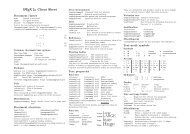Group 1
Group 1
Group 1
You also want an ePaper? Increase the reach of your titles
YUMPU automatically turns print PDFs into web optimized ePapers that Google loves.
DTU<br />
2011<br />
DESIGN FOR ELDERLY – PHASE ONE<br />
Trygve Aabye Dam, s072046<br />
Rune Schostag Nielsen, s062454<br />
42072 – Design for Interaction, <strong>Group</strong> 1 | Trygve Kelly Strong, s111255 Aabye Dam, s072<br />
Oliver Valsgaard, s082523<br />
Thorbjørn Pasgaard, s110458<br />
Thomas Paulsen, s112342
Virtual activity center for elderly<br />
Introduction<br />
This report is the final assignment in the course Interaction Design 42072 at DTU. The<br />
motivation of the project is to design a useful product or service for elderly people, which they<br />
can benefit from in their everyday. The development will focus on the interaction between the<br />
design and the elderly. The project includes user-involvement of elderly people from a Danish<br />
Activity Center for elderly.<br />
Background<br />
Today, more and more elderly are feeling lonely and are living on their own. During the last 30<br />
years, an increasing number of people are getting divorced, and the growth was especially high<br />
during the late 70‟s and early 80‟s 1 . An effect that is seen today, 40 years later as more and more<br />
couples live alone. Furthermore, the difference in life expectancy of 4.2 years between men and<br />
women, leaves many women on their own after their husband dies.<br />
According to recent research done by “Ensomme Gamles Værn”, 40.000 elderly above 60 are<br />
feeling lonely, that in addition to the people who occasionally feel abandoned, the number adds<br />
up to 112.000. Additionally, loneliness is considered to be very shameful among elderly, who are<br />
less likely to not share their situation 2 . The actual number is therefore considered to be<br />
substantially higher.<br />
Besides the more visible physical consequences, loneliness amongst elderly also results in a<br />
number of health issues. Decrease in well-being in form of depression, sleeping problems,<br />
disturbed appetite and so on are a frequent result. More pathological consequences are alcohol<br />
over-consumption, loss of self-esteem, extreme form of anxiety, powerlessness and stress.<br />
Furthermore, the risk of developing dementia is seven times higher when elderly are feeling<br />
lonely 3 . Loneliness is thus amongst the latent causes of hospitalization and of placement in<br />
nursing homes. 4<br />
Furthermore the population of elderly will increase in the future according to the European<br />
Commission and EPC 5 - Which has the potential to make these problem statements even greater<br />
and more widespread within a few decades.<br />
1 Danmarks Statistik (www.dst.dk)<br />
2 Gierveld, 1998<br />
3 Research done by the Karolinska Institute, Stockholm<br />
4 Gierveld, 1998<br />
5 Course slides Interaction Design week 6 page 10 Fall 2011 DTU<br />
2
Problem statement<br />
Today, elderly people get together in groups and play games to socialize. However, as they get<br />
older they become more and more immobilized as their musculoskeletal system becomes<br />
weakened. Thus, many elderly are forced to stay at home and an effect of that is that they<br />
become lonely. In effort to address this, a number of Activity Centers are provided by the Danish<br />
government where elderly come and do social activities with other elderly people. However, not<br />
all elderly are able to be associated with an Activity Center due to their location and going to a<br />
Activity Center only twice a week might not be satisfactory.<br />
With this project, the project group is trying to address this problem by allowing elderly people,<br />
who are living on their own, to connect with other elderly people from their homes and be able to<br />
play games with each other online. By that they will still be able to socialize, when immobilized<br />
and unable to leave their homes. Additionally the elderly should also be able to connect to a<br />
broader network of gamers, making them feel a part of a bigger social network. Thus decreasing<br />
the chances of the user feeling lonely.<br />
As the elderly tend to be rather scared of new technology and solutions, it is crucial that the<br />
design of the new interactive game has a resemblance to their everyday electronics. It is crucial<br />
that the learning curve is as flat as possible, allowing the elderly to slowly adjust to the new<br />
system. Thus making sure that as many elderly as possible who keep playing the interactive<br />
game, all joining in effort to decrease loneliness and the alarming consequences on health<br />
amongst elderly.<br />
List of requirements<br />
●<br />
●<br />
●<br />
Solution must be natural for the user by resembling their existing world, and current<br />
knowledge.<br />
Easy to use, as simple as possible. Without introducing any new interaction mediums.<br />
Help decrease loneliness.<br />
3
Cognitive-psychical considerations<br />
Different changes in physical and cognitive abilities can be observed when growing old, some of<br />
the most common changes include:<br />
●<br />
●<br />
●<br />
Decreased muscle power, making it harder to e.g. walk long distances and get up<br />
stairways<br />
Decreased sensitivity of senses, especially visual and auditory<br />
Reduced short term memory, complex tasks become harder to perform<br />
In order to counter these conditions in a product design, the following may function as general<br />
guidelines:<br />
● The product should not require heavy physical activity<br />
● Size of buttons, text and symbols have to be large<br />
● Sound<br />
○ Should be loud and clear<br />
○ Lower frequency tones are easier for elderly users to hear (500-1000 Hz range) 6<br />
● The product has to be simple to install, maintain and use – if possible not require any<br />
given instructions<br />
● Tactile feedback is preferable<br />
● All needed information should be accessible through the current display. 7<br />
Introduction to the Quizmaster<br />
The group had previously agreed upon the topic, or problem we would like to design a solution<br />
for; loneliness. The next step was to experience, through observation how the elderly are affected<br />
and respond to loneliness in their daily lives. We had arranged to spend a day at a welfare<br />
service, which is offered through the community for elderly to participate in weekly activities<br />
together. After the group‟s involvement at the community activity center we were able to make<br />
decisions on what we felt would be best for this target market based on our observations.<br />
While at the activity center we got to experience a quiz game that was more an act of social<br />
involvement than it was about competition or winning. The elderly people absolutely loved<br />
playing this game, and interacting with others. However, they would need to leave their home<br />
each time to play the game. Arranging transportation, and battling the weather in order to get to a<br />
center that was far from home wasn‟t convenient. And so the group decided to take the game,<br />
which they love and make it something that is accessible from home. It will be a challenge to<br />
6 Digital Game Design for Elderly Users, Henk Herman Nap<br />
7 Design for interaction, Lecture week 6: Design for elderly - Steen Dawids<br />
4
keep the social interaction of the players (the most important aspect of the game) prominent,<br />
while also enhancing the accessibility for the users.<br />
The home version of the quiz game will be a television quiz. The devices used between users for<br />
social interaction would of course be the graphical user interface on the TV, the phone which is<br />
used to communicate with other game participants, and as remote for responding to game<br />
questions and a webcam. It is important that each device will be as maintenance free, and user<br />
friendly as possible.<br />
Field report - Visit at elderly activity center<br />
Visit at Baunehøj activity center<br />
The 8th of November the project group visited<br />
Baunehøj Activity Center which is a common<br />
daytime activity center for elderly. The center is for<br />
elderly who are not able to leave their homes on<br />
their own, so they are picked up two to three times<br />
a week by a minivan from the center. Here the<br />
elderly can participate in different social and<br />
physical activities such as quiz games, gymnastics,<br />
sit-dance and sewing up to 3 times a week.<br />
While the group was visiting we observed the<br />
elderly do two different games, a quiz game and a<br />
word game similar to Scrabble. The most popular<br />
game among the people seems to be the quiz game,<br />
here they are all involved and can discuss the<br />
questions and answers.<br />
Meeting at the activity center<br />
Another game available at the activity center was “Wheel of fortune”, the<br />
caretakers had made their own spinning wheel for this game from the<br />
components of a scrapped wheel chair and a hospital drop stand. The reason<br />
they made their own spinning wheel was mainly to save money on an<br />
already tight budget.<br />
Word game<br />
The word game is about creating words from a given core word, e.g.<br />
“Activity center” and a caretaker is in charge of the game and writes the<br />
words on a blackboard. Each member in the game now has to come up with<br />
words that use some of the letters from the core word e.g. “Act” and each<br />
letter can only be used once.<br />
When one member has come up with a valid word the turn goes on to the<br />
next member in the game and the valid word is written on the black board<br />
5<br />
Homemade spinning wheel
y the caretaker. The game continues like this until the members cannot come up with anymore<br />
words.<br />
Example of the word game with the core word ”Halogenlamper”<br />
Quiz<br />
A group of elderly people gets together at Baunehøj Activity Center two to three times a week<br />
for a quiz. Every time they team up into two teams and compete against each other. A lot of the<br />
group members considered the quiz to be the favorite part of coming to Baunehøj as they thought<br />
it was more socially interacting than other games. By playing in teams they have to socially<br />
interact with each other to figure out “who knows what” before answering the questions.<br />
“På sporet af ordet”<br />
The day the project group was at Baunehøj, the group were playing “På sporet af ordet” (i.e.<br />
tracking the word). The caretaker from Baunehøj acted as the “quizmaster” by which she were<br />
asking the questions and helping with clues. To play the quiz, the caretaker started by picking up<br />
a card, and she would take a card and tell the group the category of the card. After that she would<br />
start by reading aloud clues from the card to pinpoint which word they had to guess.<br />
Example:<br />
Category: Term<br />
A novel about my life has been written<br />
I am best understood by a symbol<br />
I am from Greece<br />
I am the relationship between a circle‟s circumference and diameter<br />
I am approximately 3.14<br />
6
Answer: Pi<br />
While the caretaker was reading the clues aloud she gave the group quite a lot of time to consider<br />
the answer. This allowed the group to discuss the answer with each other and to come up with<br />
different answers. Sometimes the team was able to answer the question quite easily and other<br />
times the caretaker had to help them along.<br />
Social aspect of the game<br />
The competition in the quiz was not very prominent during the game, and the focus of the game<br />
was more on the social aspect and having a good experience. This was shown in the way that<br />
none of the teams were not able to answer the questions at any time, as the caretaker would help<br />
them with her own clues until they guessed it right. And when a team member from the other<br />
team accidentally answered the question for the other team, it was considered a fun feature and<br />
the group was simply happy that someone knew the answer.<br />
During the game a lot of chatting was going on to discuss the answer to the questions. Not only<br />
the team who had to answer the question was discussing, but also the competing group was<br />
whispering with each other to figure out the right answer. And at the end of the game, the<br />
caretaker told a story about the perfume “4711” and the group enjoyed to hear the story. This<br />
corresponds to the group expressing that the quiz was their favorite game because of the social<br />
aspect.<br />
Elderly and technology<br />
While talking with some of the elderly the topic of technological products was touched upon. It<br />
seems every one of them has a phone, radio and a television and that they are familiar with these<br />
products. However one of the ladies complained about the radio, she used to listen to P2 a lot,<br />
but suddenly it had changed frequency and she‟d lost it, so now she never used her radio<br />
anymore.<br />
Selected quotes<br />
“We can’t do without meeting here at the activity center” - Olga 76 years old<br />
“I had a computer before, but I always accidentally pressed somewhere and something weird<br />
happened.” - Tove 67 years old<br />
“Having a computer is too difficult” - Jens 71 years old<br />
7
Existing solutions<br />
There are many activities available for the elderly, all of which require some type of interaction<br />
from one or more individuals participating. Many claim that a person‟s participation in these<br />
interactive activities can have positive effects on the aging of the brain. It is debatable rather or<br />
not these events actually slow the progress of brain conditions such as, dementia. However,<br />
despite the lack of studies in the field, the evidence and empirical reasoning positively supports<br />
the usage of social activities amongst the elderly.<br />
The following list is an example of the most successful and popular social gaming options:<br />
· Wii<br />
· Nintendo DS<br />
· Bingo<br />
· Shuffle Board<br />
· Card games<br />
· Social Gatherings for T.V Game Shows- Jeopardy, Wheel of Fortune<br />
· Physical fitness classes- pool work outs and yoga<br />
Nintendo has been a large part of the gaming world for the past 121 years when the company<br />
was first founded to produce game cards. Since then it has very successfully produced gaming<br />
consoles that compete for the top spots, each year. 8 They‟ve come a long way from card games,<br />
as their most popular project used by seniors is the game console, the Nintendo Wii and<br />
Nintendo DS. The Wii offers its users the state-of-the-art user interaction; as the device detects<br />
your physical movements with its control, balance board or other devices. This console is<br />
frequently being used in retirement homes, to keep the seniors physically and mentally active. A<br />
less physical, Nintendo creation is the handheld console called Nintendo DS, which is typically<br />
more of a mental interaction.<br />
No matter the type of activity being performed, each revolves around social interactions. Some<br />
can argue that games are significant because of its competitive characteristics, but the problems<br />
with loneliness amongst seniors and the answers we received during our fieldwork prove<br />
otherwise. It‟s a humanistic desire to want to be social; feel involved and cared about, so no<br />
matter the activity it is important to the participants that they are interacting with others.<br />
Technical possibilities<br />
It is important that the system is left as simple as possible, for a hassle free setup. The physical<br />
system will have as few wires as possible, just one for the power cable and another as a standard<br />
connection for any television.<br />
The graphical user interface will also be as hassle free as possible. It is a priority that the setup<br />
process is fail-proof for the user. We have modeled our setup like the Apple products computer<br />
8 "Company History" (in Japanese). Nintendo. Retrieved on 2006-07-29<br />
8
setup wizard. As soon as an Apple computer is taken out of a box, and plugged in the OS setup is<br />
a step-by-step easy to use process. This simple process is a prime example of how we hope the<br />
user feels when first starting their new gaming device.<br />
The product will consist of a hub, and two other devices that connect to it. The hub will act as a<br />
home, or charging station for the devices and as the „brain‟ of the system; due to most processes<br />
going through it. The physical hub device will be small enough to fit easily below or beside any<br />
television set.<br />
A wireless camera will sit above or below the television that is set-up free. The only interaction<br />
the user will need to cooperate with the camera is deciding where it sits still. The camera will<br />
have a wide aperture, making it easy to pinpoint the user in front of it.<br />
A cordless „phone‟ like device will also be a part of the system. The phone will also act as a<br />
remote, for the user to interact with the screen.<br />
Finally, the system will be equipped with a Sim card for wireless internet capabilities. A monthly<br />
subscription fee will allow companies to „lease‟ the system and create an option for family<br />
members to communicate with the system via online access or through an app.<br />
Mock-up and physical sketches<br />
The following drawings are the initial prototypes of the interactive game Quizmaster. The<br />
physical setup contains drawings of the device, remote control and webcam together with a list<br />
of options on how to connect the devices.<br />
Box<br />
9
Remote Control<br />
Controller<br />
10
Webcam<br />
The following mock-up shows the different screens that the elderly will interact with. A brief<br />
explanation of every screen is written directly on the wireframes and the actions between those.<br />
The initial setup will only be shown when you start up the device the first time. That is the first<br />
and last time the users have to interact with those screens. From then, the start screen<br />
(Quizmaster The Game) will be the Quizmaster Main Screen where gaming with elderly friends<br />
is accessible from.<br />
11
Initial Setup
Quizmaster The Game
















